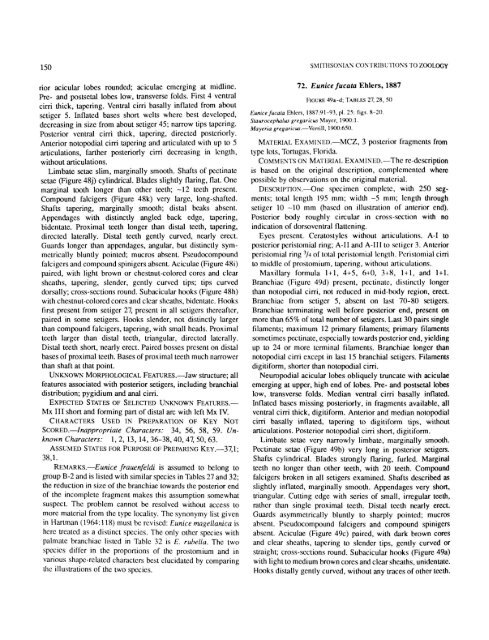A Review of the Genus Eunice - Smithsonian Institution Libraries
A Review of the Genus Eunice - Smithsonian Institution Libraries
A Review of the Genus Eunice - Smithsonian Institution Libraries
Create successful ePaper yourself
Turn your PDF publications into a flip-book with our unique Google optimized e-Paper software.
150 SMITHSONIAN CONTRIBUTIONS TO ZOOLOGY<br />
rior acicular lobes rounded; aciculae emerging at midline.<br />
Pre- and postsetal lobes low, transverse folds. First 4 ventral<br />
cirri thick, tapering. Ventral cirri basally inflated from about<br />
setiger 5. Inflated bases short welts where best developed,<br />
decreasing in size from about setigcr 45; narrow tips tapering.<br />
Posterior ventral cirri thick, tapering, directed posteriorly.<br />
Anterior notopodial cirri tapering and articulated with up to 5<br />
articulations, far<strong>the</strong>r posteriorly cirri decreasing in length,<br />
without articulations.<br />
Limbate setae slim, marginally smooth. Shafts <strong>of</strong> pectinate<br />
setae (Figure 48j) cylindrical. Blades slightly flaring, flat. One<br />
marginal tooth longer than o<strong>the</strong>r teeth; -12 teeth present.<br />
Compound falcigers (Figure 48k) very large, long-shafted.<br />
Shafts tapering, marginally smooth; distal beaks absent.<br />
Appendages with distinctly angled back edge, tapering,<br />
bidentatc. Proximal teeth longer than distal teeth, tapering,<br />
directed laterally. Distal teeth gently curved, nearly erect.<br />
Guards longer than appendages, angular, but distinctly symmetrically<br />
bluntly pointed; mucros absent. Pscudocompound<br />
falcigers and compound spinigcrs absent. Aciculae (Figure 48i)<br />
paired, with light brown or chestnut-colored cores and clear<br />
sheaths, tapering, slender, gently curved tips; tips curved<br />
dorsally; cross-sections round. Subacicular hooks (Figure 48h)<br />
with chestnut-colored cores and clear sheaths, bidentatc. Hooks<br />
first present from setiger 27, present in all sctigcrs <strong>the</strong>reafter,<br />
paired in some sctigers. Hooks slender, not distinctly larger<br />
than compound falcigers, tapering, with small heads. Proximal<br />
teeth larger than distal teeth, triangular, directed laterally.<br />
Distal teeth short, nearly erect. Paired bosses present on distal<br />
bases <strong>of</strong> proximal teeth. Bases <strong>of</strong> proximal teeth much narrower<br />
than shaft at that point.<br />
UNKNOWN MORPHOLOGICAL FEATURES.—Jaw structure; all<br />
features associated with posterior setigers, including branchial<br />
distribution; pygidium and anal cirri.<br />
EXPECTED STATES OF SELECTED UNKNOWN FEATURES.—<br />
Mx III short and forming part <strong>of</strong> distal arc with left Mx IV.<br />
CHARACTERS USED IN PREPARATION OF KEY NOT<br />
SCORED.—Inappropriate Characters: 34, 56, 58, 59. Unknown<br />
Characters: 1, 2, 13, 14, 36-38,40, 47, 50, 63.<br />
ASSUMED STATES FOR PURPOSE OF PREPARING KEY.—37,1;<br />
38,1.<br />
REMARKS.—<strong>Eunice</strong> frauenfeldi is assumed to belong to<br />
group B-2 and is listed with similar species in Tables 27 and 32;<br />
<strong>the</strong> reduction in size <strong>of</strong> <strong>the</strong> branchiae towards <strong>the</strong> posterior end<br />
<strong>of</strong> <strong>the</strong> incomplete fragment makes this assumption somewhat<br />
suspect. The problem cannot be resolved without access to<br />
more material from <strong>the</strong> type locality. The synonymy list given<br />
in Hartman (1964:118) must be revised: <strong>Eunice</strong> magellanica is<br />
here treated as a distinct species. The only o<strong>the</strong>r species with<br />
palmate branchiae listed in Table 32 is E. rubella. The two<br />
species differ in <strong>the</strong> proportions <strong>of</strong> <strong>the</strong> prostomium and in<br />
various shape-related characters best elucidated by comparing<br />
<strong>the</strong> illustrations <strong>of</strong> <strong>the</strong> two species.<br />
72. <strong>Eunice</strong> fucata Ehlers, 1887<br />
FIGURE 49a-d; TABLES 27,28, 50<br />
<strong>Eunice</strong> fucata Ehlers. 1887:91-93, pi. 25: figs. 8-20.<br />
Staurocephalus gregaricus Mayer, 1900:1.<br />
Mayeria gregaricus.—Vcrrill, 1900:650.<br />
MATERIAL EXAMINED.—MCZ, 3 posterior fragments from<br />
type lots, Tortugas, Florida.<br />
COMMENTS ON MATERIAL EXAMINED.—The rc-description<br />
is based on <strong>the</strong> original description, complemented where<br />
possible by observations on <strong>the</strong> original material.<br />
DESCRIPTION.—One specimen complete, with 250 segments;<br />
total length 195 mm; width ~5 mm; length through<br />
sctiger 10 -10 mm (based on illustration <strong>of</strong> anterior end).<br />
Posterior body roughly circular in cross-section with no<br />
indication <strong>of</strong> dorsovcntral flattening.<br />
Eyes present. Ccratostylcs without articulations. A-I to<br />
posterior pcristomial ring; A-I I and A-I 11 to setiger 3. Anterior<br />
per is torn ial ring 3 /" <strong>of</strong> total pcristomial length. Peristomial cirri<br />
to middle <strong>of</strong> prostomium, tapering, without articulations.<br />
Maxillary formula 1+1, 4+5, 6+0, 3 + 8, 1 + 1, and 1+1.<br />
Branchiae (Figure 49d) present, pectinate, distinctly longer<br />
than notopodial cirri, not reduced in mid-body region, erect.<br />
Branchiae from setigcr 5, absent on last 70-80 sctigcrs.<br />
Branchiae terminating well before posterior end, present on<br />
more than 65% <strong>of</strong> total number <strong>of</strong> setigcrs. Last 30 pairs single<br />
filaments; maximum 12 primary filaments; primary filaments<br />
sometimes pectinate, especially towards posterior end, yielding<br />
up to 24 or more terminal filaments. Branchiae longer than<br />
notopodial cirri except in last 15 branchial setigers. Filaments<br />
digitiform, shorter than notopodial cirri.<br />
Neuropodial acicular lobes obliquely truncate with aciculae<br />
emerging at upper, high end <strong>of</strong> lobes. Pre- and postsetal lobes<br />
low, transverse folds. Median ventral cirri basally inflated.<br />
Inflated bases missing posteriorly, in fragments available, all<br />
ventral cirri thick, digitiform. Anterior and median notopodial<br />
cirri basally inflated, tapering to digitiform tips, without<br />
articulations. Posterior notopodial cirri short, digitiform.<br />
Limbate setae very narrowly limbate, marginally smooth.<br />
Pectinate setae (Figure 49b) very long in posterior setigers.<br />
Shafts cylindrical. Blades strongly flaring, furled. Marginal<br />
teeth no longer than o<strong>the</strong>r teeth, with 20 teeth. Compound<br />
falcigers broken in all sctigers examined. Shafts described as<br />
slightly inflated, marginally smooth. Appendages very short,<br />
triangular. Cutting edge with series <strong>of</strong> small, irregular teeth,<br />
ra<strong>the</strong>r than single proximal teeth. Distal teeth nearly erect.<br />
Guards asymmetrically bluntly to sharply pointed; mucros<br />
absent. Pseudocompound falcigers and compound spinigers<br />
absent. Aciculae (Figure 49c) paired, with dark brown cores<br />
and clear sheaths, tapering to slender lips, gently curved or<br />
straight; cross-sections round. Subacicular hooks (Figure 49a)<br />
with light to medium brown cores and clear sheaths, unidentate.<br />
Hooks distally gently curved, without any traces <strong>of</strong> o<strong>the</strong>r teeth.
















